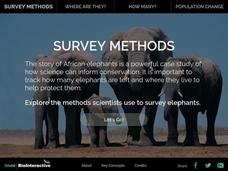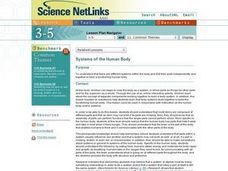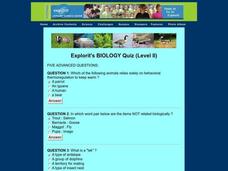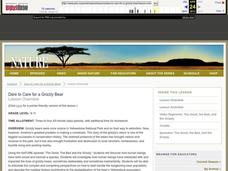Curated OER
Gravity Versus The Mighty Egg - Biology Teaching Thesis
Students are able to describe the principles of gravity. They name other places in the real world where we compensate for gravity. Students design a shock absorber with limited materials and explain how it works to protect an egg. They...
Howard Hughes Medical Institute
Survey Methods
How many African elephants are on earth? How do scientists answer a question like that? An interactive resource explains a variety of survey methods and their advantages and disadvantages. It connects the need for a survey to...
Discovery Education
The Science of Addiction: The Story of Teens
Users of Discovery Education's interactive on the biology of addiction examine common misconceptions about opioids and learn about the factors that cause addiction. Additionally, they listen to the stories of three teens and their...
Teach Engineering
Food Chains and Food Webs - Balance within Natural Systems
Feast on an informative resource. Scholars learn about food chains and food webs and how these interactions give information about the natural community. A PowerPoint presentation provides information about this concept.
BW Walch
Solving Exponential Equations
Introducing exponential equations means learners need to take all the rules and tricks they learned for exponents and actually apply them. This presentation comes to the rescue by touching on changing bases in exponential...
BW Walch
Creating and Graphing Exponential Equations
Frequently found in biology and economic application problems, exponential equations show up as stars in this introductory presentation. Taking no background or knowledge of exponentials for granted, the slides walk learners...
Royal Society of Chemistry
pH 2: Activity
Pupils puzzled over pH? Incorporate an interactive resource that teaches through games! Chemistry scholars use reasoning to solve puzzles that focus on determining the pH based upon hydrogen ion concentration.
Google
Biochemical Structures
It's truly amazing how life is sustained through the complicated interactions of different organic compounds. As young biochemists complete this worksheet, they demonstrate their ability to identify these essential molecules as well as...
LABScI
Circulation and Respiration: Vital Signs
What do your vital signs tell your doctor? An engaging hands-on lesson has your learners monitor their own lung capacity, blood pressure, and heart rate. They then connect the vital measures to the workings of the circulatory and...
Curated OER
Explorit's Biology Quiz
In this biology worksheet, students complete a five question multiple choice on-line interactive quiz about animal and plant biology.
Curated OER
Population Biology
High schoolers define the following terms: predation, competition, carrying capacity and population. They can explain the patterns of growth and the limitations of growth. Students explain the difference between density-dependent and...
Curated OER
Non-covalent Interactions of Molecules
Learners participate in a class discussion about non-covalent interactions of molecules forming and shaping the macromolecules essential in biology. Handout provided is used as an outline for discussion.
Curated OER
Genome Interactions
In this genome interactions worksheet, students read the passage about genome interactions then apply the knowledge to answer several short answer questions.
Curated OER
Biology: Systems of the Human Body
Students examine the different systems of the human body and how they work independently and cooperatively. They complete sevral online interactive projects designed to reinforce how the systems work alone and together. Students make...
Curated OER
Explorit's Biology Quiz
In this biology worksheet, students complete a five question on-line interactive multiple choice quiz about animal biology. This quiz has more advanced material.
Virginia Department of Education
The Germ Theory and Koch’s Postulates
Explore the history of cholera and its effect on society with your biology class. Young biologists will then proceed to grow their own germs, prepared from live cultures, and follow the steps of the scientific method to generate data....
Curated OER
Peregrine Falcon
Young environmentalists study the effects that pesticides have on birds, such as the peregrine falcon. They also look at predator/prey interactions. Some wonderful in-class activities accompany an inventive lesson. After an activity that...
Curated OER
Survival of the Fastest: Predator and Prey in the African Savannah
Students explore the predator-prey relationship using an interactive game. For this biology lesson, students compare their physical attributes. They explain how predators develop to make it stronger and efficient as hunters. Each...
Curated OER
Proteomics
Young scholars analyze data taken from proteomic experiments. In this biology lesson, students explain the importance of bioinformatics tools in the study of proteins. They evaluate scientific results using math and computer software.
Curated OER
The Froggy Page
Students investigate the cycle of life by observing tadpoles. In this biology lesson plan, students utilize the Internet to read stories, observe pictures, and listen to sounds of frogs. Students create a poster board collage...
Curated OER
Creating the "Perfect" Horse
Students examine the relationship between a horse and its rider. In this behavior and interactions activity students research the Internet to learn about horse behavior and biology then write a paper and present it to the class.
Curated OER
Bird Brained?
Students identify general abilities that indicate animal cognitive intelligence. In this biology lesson, students create an intelligence testing challenge for ravens. They compare its ability to that of a crow.
Curated OER
The Great Pollinators
Young scholars discover the reproductive parts of a plant. In this biology lesson, students identify and categorize several different plants they dissect in class. Young scholars record their information using a data chart.
Curated OER
Dare to Care for a Grizzly Bear
Students examine the relationship between humans and grizzly bears. In this biology lesson, students research about the bear's habits and living environment. They write a letter to the US Fish and Wildlife Service petitioning them to...























